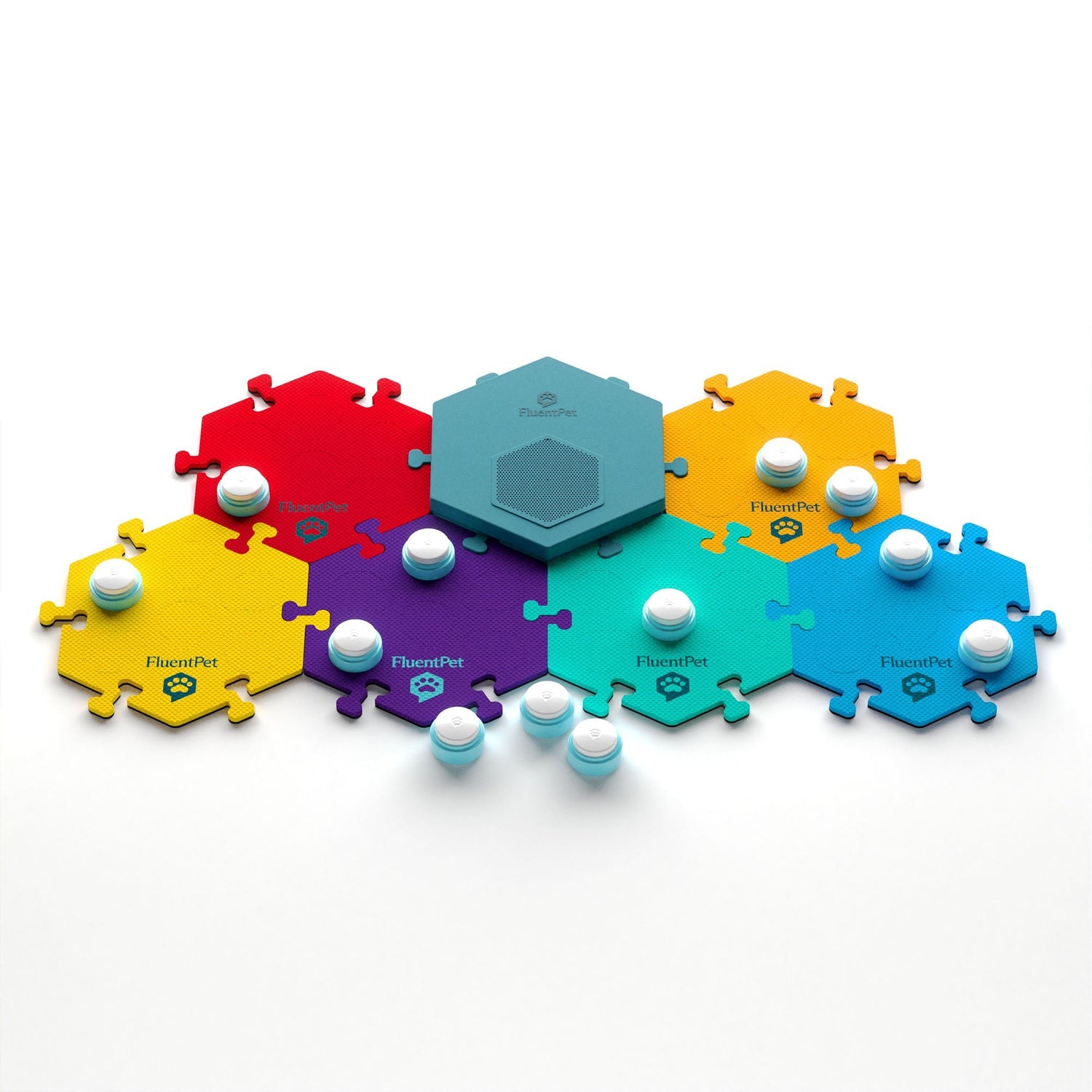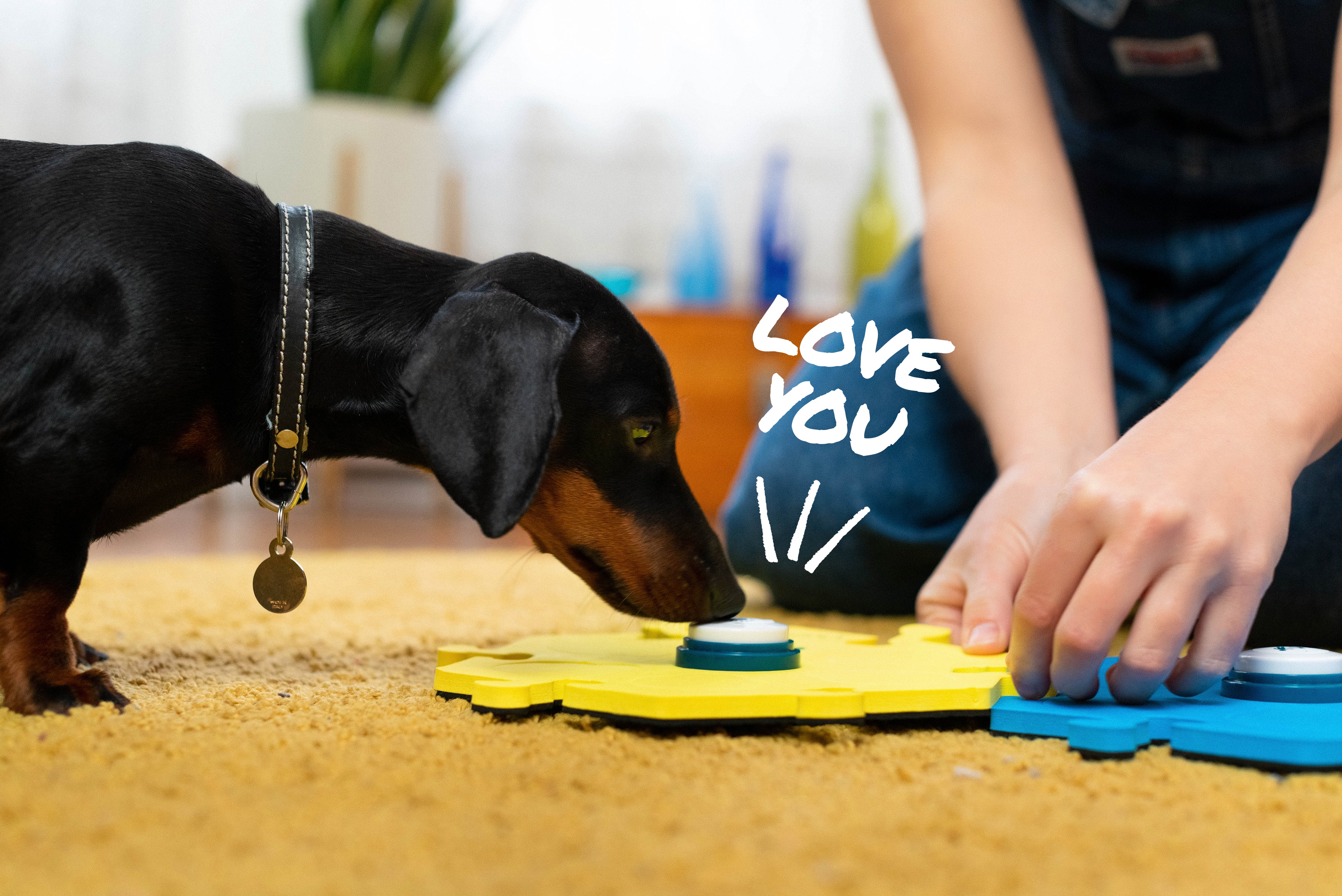
Since we started FluentPet, our customers—especially those with a lot of buttons—were excited about tracking which buttons their learners pressed and when. They kept journals and created online forms for logging each interaction. Some even built entire “dog computers” that automatically registered each button press and used it to update a real-time data visualization dashboard. And all of these surprising developments by our customers happened within a year of FluentPet being launched!
While it was clear that customers wanted to track their learners’ button presses, in the process of developing the tools to accomplish this we also saw an opportunity to re-imagine the FluentPet soundboard from the ground up.
This led to an integrated HexTile design that offered a wide range of benefits:
- It was more durable
- The buttons were more responsive and easier to press
- It (of course) allowed for automated button press tracking
Based on our 1.5 years of continuous communication with some of our community's more experienced button teachers, we believed we had developed the best possible design. However, last spring, as our users tested the system, and as we came to the final steps of manufacturing, we uncovered some critical design issues. In particular:
- The cost of soundboard conversion for existing button teachers
- Risks associated with learners transferring to entirely new and different hardware
- The impact of HexTile-based pricing on how new teachers build their soundboards
Soundboard Conversion Costs
We knew that a large number of those who were most enthusiastic about connected buttons already had learners with lots of buttons and had invested heavily in their HexTile systems. With the new FluentPet Connect design, this would mean a dramatic and expensive change to their sound boards, with the complete replacement of every single HexTile.
The cost involved was even more considerable because many teachers, very sensibly, were not filling each of their HexTiles with buttons: either because their learner wasn’t a very precise presser, or because they wanted to spread the buttons out to better organize their learner’s concepts.
If one of these teachers were to convert a soundboard with 36 buttons distributed over 10 HexTiles, then under the original system this would have meant a cost of 1 x $69.95 (Base) + 9 x $49.95 (Expansion) = $519.50. With the new version of FluentPet Connect, conversion cost would instead be 1 x 69.95 (Base) + $299.95 (price of a 36 button Connect bundle) = $369.95. This difference of ~$150 (40%) would of course be even more dramatic if there were more HexTiles involved.
Hardware Change Impact
While our testers reported that learners did okay with FluentPet Connect, we nonetheless received feedback that the dramatic change in buttons and HexTiles could potentially pose a problem for learners.
With the new button-centered design, the only meaningful change for learners is the buttons themselves, and the location where the sound is coming from: the HexTiles remain identical and familiar, and even the buttons themselves are virtually identical to the ones they’re replacing.
Since button teaching is an entirely new phenomenon that is at best poorly understood, as a company we are trying our best to avoid making sudden dramatic changes to learners’ soundboards, lest this unexpectedly get in the way of learner communication.
Implications for New Users
Lastly, one key suggestion we've received from the most experienced teachers and learners is to spread buttons out among multiple HexTiles, and to, at least at first, avoid filling HexTiles with buttons. A full HexTile is likely to be more confusing to a learner, and for learners who are sloppy in their presses, it can lead to accidental pressing.
Spreading buttons out across multiple HexTiles allows for early division by part-of-speech and minimizes the probability that a learner will fail to remember a button’s precise location.
Unfortunately, with the original approach of FluentPet Connect, the economics discourage users from engaging in the suggested best practice of initially limiting the number of buttons per HexTile.
What’s next?
We’re working to make it easy, fast, and affordable for anyone who wants to transition to FluentPet Connect.
No one in history has previously brought to market specialized, internet-connected hardware that’s designed to help dogs and cats learn language-like communication.
We undoubtedly would have preferred to have made these changes earlier in our process, but we all believe that it’s better to ship the right solution a bit later than to ship the wrong solution on time.
It's been a journey, but we remain passionately convinced that the Connected Button approach is the one most likely to lead to an effortless and economical transition for button teachers.
-Leo
Founder, FluentPet

Check out our new line of Connect products here.
FAQs
Does this mean it won't be rechargeable?
In all our designs for FluentPet Connect, only the Base HexTile, which maintains the WiFi connection, was going to be rechargeable. The rest run on disposable batteries. We dislike them as much as anyone, but the batteries are designed to last for a year (ideally three or four!) under normal use.
I've already purchased Connect. What happens now?
All payments you've made are eligible to be credited to the purchase of a FluentPet Connect system or fully refunded.




Leave a comment
This site is protected by hCaptcha and the hCaptcha Privacy Policy and Terms of Service apply.